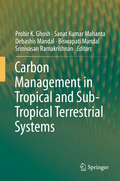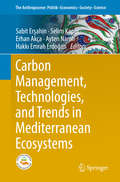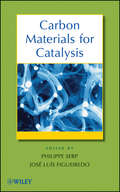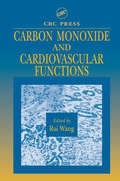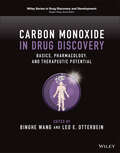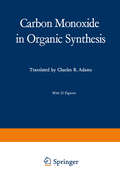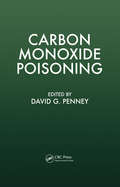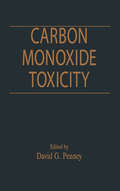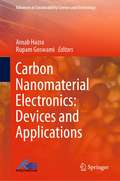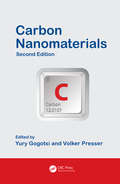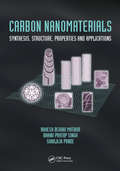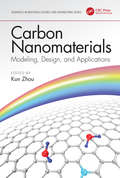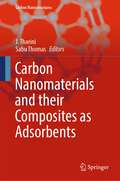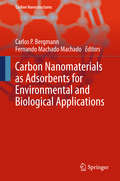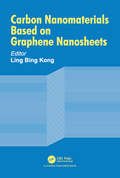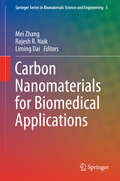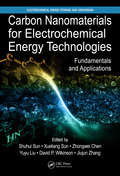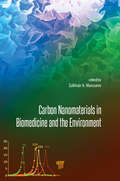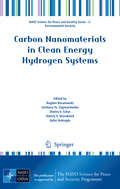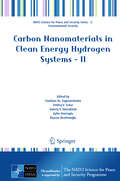- Table View
- List View
Carbon Management in Tropical and Sub-Tropical Terrestrial Systems
by Probir K. Ghosh Sanat Kumar Mahanta Debashis Mandal Biswapati Mandal Srinivasan RamakrishnanSoil organic carbon (SOC), a key component of the global carbon (C) pool, plays an important role in C cycling, regulating climate, water supplies and biodiversity, and therefore in providing the ecosystem services that are essential to human well-being. Most agricultural soils in temperate regions have now lost as much as 60% of their SOC, and as much as 75% in tropical regions, due to conversion from natural ecosystems to agricultural uses and mainly due to continuous soil degradation. Sequestering C can help to offset C emissions from fossil fuel combustion and other C-emitting activities, while also enhancing soil quality and long-term agronomic productivity. However, developing effective policies for creating terrestrial C sinks is a serious challenge in tropical and subtropical soils, due to the high average annual temperatures in these regions. It can be accomplished by implementing improved land management practices that add substantial amounts of biomass to soil, cause minimal soil disturbance, conserve soil and water, improve soil structure, and enhance soil fauna activity. Continuous no-till crop production is arguably the best example. These soils need technically sound and economically feasible strategies to sustainably enhance their SOC pools. Hence, this book provides comprehensive information on SOC and its management in different land-use systems, with a focus on preserving soils and their ecosystem services. The only book of its kind, it offers a valuable asset for students, researchers, policymakers and other stakeholders involved in the sustainable development and management of natural resources at the global level.
Carbon Management, Technologies, and Trends in Mediterranean Ecosystems (The Anthropocene: Politik—Economics—Society—Science #15)
by Sabit Erşahin Selim Kapur Erhan Akça Ayten Namlı Hakkı Emrah ErdoğanThis book pursues a unique approach, investigating both the ecological and socio-economic aspects of carbon management in Mediterranean ecosystems. All chapters are based on papers originally presented at the 1st Istanbul Carbon Summit, held at Istanbul Technical University, 2–4 April, 2014, and revised following a peer-review process.The book addresses the summit’s three main themes – carbon management, carbon technologies, and carbon trends – while also offering chapters on the economic aspects of carbon management and the ecological aspects of the carbon cycle. The chapters on economic aspects analyze the carbon trade and its institutional, political, and legislative structures in different Mediterranean nations, while those on ecological aspects review the discourse on and analysis of the related ecological factors and their feedback due to governance processes.
Carbon Materials for Catalysis
by Philippe Serp Jos 233 Luis FigueiredoThis is the first comprehensive book covering all aspects of the use of carbonaceous materials in heterogeneous catalysis. It covers the preparation and characterization of carbon supports and carbon-supported catalysts; carbon surface chemistry in catalysis; the description of catalytic, photo-catalytic, or electro-catalytic reactions, including the development of new carbon materials such as carbon xerogels, aerogels, or carbon nanotubes; and new carbon-based materials in catalytic or adsorption processes. This is a premier reference for carbon, inorganic, and physical chemists, materials scientists and engineers, chemical engineers, and others.
Carbon Monoxide and Cardiovascular Functions
by Rui WangAkin to nitric oxide, carbon monoxide (CO) was initially viewed as a pure toxic gas, yet it has been recently demonstrated to be an important endogenous molecule of gas that has profound physiological and pathophysiological effects on the cardiovascular system. In spite of the growing understanding achieved in this field, until now a comprehensive
Carbon Monoxide in Drug Discovery: Basics, Pharmacology, and Therapeutic Potential (Wiley Series in Drug Discovery and Development)
by Leo E. Otterbein Binghe WangCARBON MONOXIDE IN DRUG DISCOVERY An insightful reference for the latest physiological and therapeutic studies of carbon monoxide In Carbon Monoxide in Drug Discovery: Basics, Pharmacology, and Therapeutic Potential, a team of distinguished authors delivers foundational knowledge, the latest research, and remaining challenges regarding the physiological roles and therapeutic efficacy of carbon monoxide (CO). The editors have included a broad selection of resources from leading experts in the field that discuss the background and physiological roles of CO, a variety of delivery forms including CO prodrugs using benign carriers, CO sensing, therapeutic applications, and clinical trials. Organized by topic to allow each chapter to be read individually, the book covers a wide range of topics, from physiological and patho-physiological mechanisms at the molecular level to clinical applications for multiple disease processes. The editors of Carbon Monoxide in Drug Discovery have created a compelling argument for shifting the accepted understanding of CO from poison to bioactive molecule with enormous clinical benefits. Readers will also benefit from: A thorough introduction to the background and physiological actions of carbon monoxide, including endogenous CO production in sickness and in health Comprehensive explorations of CO delivery forms, including non-carrier formulations, metal-carbonyl complexes, and organic CO donors Practical discussions of carbon monoxide sensing and scavenging, including fluorescent probes for intracellular carbon monoxide detection In-depth examinations of the therapeutic applications of CO, including CO in solid organ transplantation Perfect for professors, graduate students, and postdocs in the fields of biology, pharmacology, immunology, medicinal chemistry, toxicology, and drug delivery, Carbon Monoxide in Drug Discovery: Basics, Pharmacology, and Therapeutic Potential is also an invaluable resource for industrial scientists in these areas.
Carbon Monoxide in Drug Discovery: Basics, Pharmacology, and Therapeutic Potential (Wiley Series in Drug Discovery and Development)
by Binghe Wang Leo E. OtterbeinCARBON MONOXIDE IN DRUG DISCOVERY An insightful reference for the latest physiological and therapeutic studies of carbon monoxide In Carbon Monoxide in Drug Discovery: Basics, Pharmacology, and Therapeutic Potential, a team of distinguished authors delivers foundational knowledge, the latest research, and remaining challenges regarding the physiological roles and therapeutic efficacy of carbon monoxide (CO). The editors have included a broad selection of resources from leading experts in the field that discuss the background and physiological roles of CO, a variety of delivery forms including CO prodrugs using benign carriers, CO sensing, therapeutic applications, and clinical trials. Organized by topic to allow each chapter to be read individually, the book covers a wide range of topics, from physiological and patho-physiological mechanisms at the molecular level to clinical applications for multiple disease processes. The editors of Carbon Monoxide in Drug Discovery have created a compelling argument for shifting the accepted understanding of CO from poison to bioactive molecule with enormous clinical benefits. Readers will also benefit from: A thorough introduction to the background and physiological actions of carbon monoxide, including endogenous CO production in sickness and in health Comprehensive explorations of CO delivery forms, including non-carrier formulations, metal-carbonyl complexes, and organic CO donors Practical discussions of carbon monoxide sensing and scavenging, including fluorescent probes for intracellular carbon monoxide detection In-depth examinations of the therapeutic applications of CO, including CO in solid organ transplantation Perfect for professors, graduate students, and postdocs in the fields of biology, pharmacology, immunology, medicinal chemistry, toxicology, and drug delivery, Carbon Monoxide in Drug Discovery: Basics, Pharmacology, and Therapeutic Potential is also an invaluable resource for industrial scientists in these areas.
Carbon Monoxide in Organic Synthesis (Organische Chemie in Einzeldarstellungen #10)
by Jürgen FalbeThis book reviews some important reactions of carbon monoxide in organic chemistry: hydroformylation, metal carbonyl- and acid catalyzed carbonylation and ring closure reactions with carbon monoxide. It is not merely a translation of the German edition which appeared in 1967 but the text has been completely revised. This was necessary because this chemistry is rapidly developing in research as well as in technical application, which is underlined by the increase of production of e. g. oxo chemicals from about 1.4 million tons in 1967 to 2.7 million tons in 1969, nearly a doubling within 2 years. Quite a number of new research results were published during the last two years, and these additional references have been cited in the English edition. Most of the new papers cited deal with hydroformylation reactions: however, a number of the papers reviewed also report important new aspects in carboxylation and ring closure reactions. The author is indebted to a number of colleagues who helped to collect these new data and have given him valuable hints and would like to thank Miss 1. Forster, Dr. B. Cornils, Dr. D. Hahn, Dr. P. Schneller, Dr. H. Tummes, and Dr. J. Weber for their cooperation, and to Prof. Dr. F. Piacenti (University of Pisa, Italy) for discussions on reaction mecha nisms. The author is especially grateful to Dr. Charles R. Adams of the Shell Development Company, Emeryville, California, for his cooperation in translating the German text.
Carbon Monoxide Poisoning
by David G. PenneyWhile an ever-present and familiar toxin, carbon monoxide (CO) remains the number one poison in our environment. This silent killer is responsible for over 2,000 deaths a year in the United States alone. The public and healthcare communities need quality information about the many risks presented by carbon monoxide exposure. Edited by a leading e
Carbon Monoxide Toxicity
by David G. PenneyPublic interest in the health impacts of carbon monoxide (CO) has been increasing rapidly during the past decade. And rightly so: it is the most ubiquitous environmental poison. Car exhaust fumes, furnaces, gas-powered engines, home water heaters, smoke from all types of fire, and tobacco smoke all contribute to carbon monoxide intoxication - the l
Carbon Nanomaterial Electronics: Devices and Applications (Advances in Sustainability Science and Technology)
by Arnab Hazra Rupam GoswamiThis book brings together selective and specific chapters on nanoscale carbon and applications, thus making it unique due to its thematic content. It provides access to the contemporary developments in carbon nanomaterial research in electronic applications. Written by professionals with thorough expertise in similar broad area, the book is intended to address multiple aspects of carbon research in a single compiled edition. It targets professors, scientists and researchers belonging to the areas of physics, chemistry, engineering, biology and medicine, and working on theory, experiment and applications of carbon nanomaterials.
Carbon Nanomaterials: Second Edition
by Yury Gogotsi Volker PresserThis book provides information on synthesis, properties, and applications of carbon nanomaterials. With novel materials, such as graphene (atomically flat carbon) or carbon onions (carbon nanospheres), the family of carbon nanomaterials is rapidly growing. This book provides a state-of-the-art overview and in-depth analysis of the most important ca
Carbon Nanomaterials: Synthesis, Structure, Properties and Applications
by Rakesh Behari Mathur Bhanu Pratap Singh Shailaja PandeThe study of nanostructures has become, in recent years, a theme common to many disciplines, in which scientists and engineers manipulate matter at the atomic and molecular level in order to obtain materials and systems with significantly improved properties. Carbon nanomaterials have a unique place in nanoscience owing to their exceptional thermal, electrical, chemical, and mechanical properties, finding application in areas as diverse as super strong composite materials, energy storage and conversion, supercapacitors, smart sensors, targeted drug delivery, paints, and nanoelectronics. This book is the first to cover a broad spectrum of carbon nanomaterials, namely carbon nanofibers, vapor-grown carbon fibers, different forms of amorphous nanocarbons besides carbon nanotubes, fullerenes, graphene, graphene nanoribbons, graphene quantum dots, etc. in a single volume.
Carbon Nanomaterials: Synthesis, Structure, Properties and Applications
by Rakesh Behari Mathur Bhanu Pratap Singh Shailaja PandeThe study of nanostructures has become, in recent years, a theme common to many disciplines, in which scientists and engineers manipulate matter at the atomic and molecular level in order to obtain materials and systems with significantly improved properties. Carbon nanomaterials have a unique place in nanoscience owing to their exceptional thermal, electrical, chemical, and mechanical properties, finding application in areas as diverse as super strong composite materials, energy storage and conversion, supercapacitors, smart sensors, targeted drug delivery, paints, and nanoelectronics. This book is the first to cover a broad spectrum of carbon nanomaterials, namely carbon nanofibers, vapor-grown carbon fibers, different forms of amorphous nanocarbons besides carbon nanotubes, fullerenes, graphene, graphene nanoribbons, graphene quantum dots, etc. in a single volume.
Carbon Nanomaterials: Modeling Design And Applications (Advances in Materials Science and Engineering)
by Kun ZhouCarbon Nanomaterials: Modeling, Design, and Applications provides an in-depth review and analysis of the most popular carbon nanomaterials, including fullerenes, carbon nanotubes, graphene and novel carbon nanomaterial-based membranes and thin films, with emphasis on their modeling, design and applications. This book provides basic knowledge of the structures, properties and applications of carbon-based nanomaterials. It illustrates the fundamental structure-property relationships of the materials in both experimental and modeling aspects, offers technical guidance in computational simulation of nanomaterials, and delivers an extensive view on current achievements in research and practice, while presenting new possibilities in the design and usage of carbon nanomaterials. This book is aimed at both undergraduate and graduate students, researchers, designers, professors, and professionals within the fields of materials science and engineering, mechanical engineering, applied physics, and chemical engineering.
Carbon Nanomaterials and their Composites as Adsorbents (Carbon Nanostructures)
by Sabu Thomas J. ThariniThis book elucidates fundamental concepts of nanomaterials and their pivotal role as nanoadsorbents in water purification. Key features include the latest trends in adsorption for metal, micro pollutants, food adulterants, aromatic compounds, pesticides, dyes, and oil particle removal. Additionally, the interdisciplinary aspects of adsorption and practical applications for hazardous chemical removal from water are explored. The book delves into various types of adsorption isotherms such as Langmuir, Freundlich, BET, and others, offering a deep understanding for water purification. Kinetic models including first, second, and third order kinetics are elucidated, empowering undergraduate students to grasp and optimize complex systems. The required background is basic knowledge in chemistry, biology, mathematics, and nanoscience at the first-year university level. Designed for both academics and industrial researchers, this book is divided into 17 chapters. Chapters 1-7 introduce nanomaterials, carbon nanoadsorbents, their synthesis, and surface modification. Chapters 8-9 cover fundamental adsorption isotherms, kinetic models, thermodynamic parameters, adsorption mechanism, and experimental techniques. Chapters 10-15 delve into the adsorption and desorption of various compounds like aromatic compounds, pesticides, heavy metals, micro pollutants, food adulterants, oil particles, and dyes molecules. The final chapter tackles the theoretical modeling of carbon nanomaterials for adsorption studies
Carbon Nanomaterials as Adsorbents for Environmental and Biological Applications (Carbon Nanostructures)
by Carlos P. Bergmann Fernando Machado MachadoThis book presents a summary of the current use of carbon nanomaterials for water treatment, drug delivery, systems and nanosensors. The first chapter elucidates the adsorption process phenomenon. Also, the properties of different carbon nanomaterials for adsorption applications are covered. The third chapter presents the kinetic and equilibrium models of adsorption, processing of experimental data and adsorption process peculiarities. Environmental and biological applications of carbon nanomaterials are listed in the last chapter. This book is written from an application-oriented perspective and is useful for all those interested in nanoadsorbents.
Carbon Nanomaterials Based on Graphene Nanosheets
by Ling Bing KongSince the discovery of graphene, it has become one of the most widely and extensively studied materials. This book aims to summarize the progress in synthesis, processing, characterization and applications of a special group of nanocarbon materials derived from graphene or graphene related derivatives by using various strategies in different forms. More specifically, three forms of macrosized materials are presented, i.e., one-dimension or 1D (fibers, wires, yarns, streads, etc.), two-dimension or 2D (films, membranes, papers, sheets, etc.) and three-dimension or 3D (bulk, hydrogels, aerogels, foams, sponges, etc.). Seven chapters are included with the first chapter serving to introduce the concept, definition, and nomenclature of graphene, graphene oxide and their derivatives. The main topics are covered in Chapters 2‒7. Although they have coherent connections, each chapter of them is designed such that they can be studied independently. The target readers of this book include undergraduate students, postgraduate students, researchers, designers, engineers, professors, and program/project managers from the fields of materials science and engineering, applied physics, chemical engineering, biomaterials, materials manufacturing and design, institutes, and research founding agencies.
Carbon Nanomaterials Based on Graphene Nanosheets
by Ling Bing KongSince the discovery of graphene, it has become one of the most widely and extensively studied materials. This book aims to summarize the progress in synthesis, processing, characterization and applications of a special group of nanocarbon materials derived from graphene or graphene related derivatives by using various strategies in different forms. More specifically, three forms of macrosized materials are presented, i.e., one-dimension or 1D (fibers, wires, yarns, streads, etc.), two-dimension or 2D (films, membranes, papers, sheets, etc.) and three-dimension or 3D (bulk, hydrogels, aerogels, foams, sponges, etc.). Seven chapters are included with the first chapter serving to introduce the concept, definition, and nomenclature of graphene, graphene oxide and their derivatives. The main topics are covered in Chapters 2‒7. Although they have coherent connections, each chapter of them is designed such that they can be studied independently. The target readers of this book include undergraduate students, postgraduate students, researchers, designers, engineers, professors, and program/project managers from the fields of materials science and engineering, applied physics, chemical engineering, biomaterials, materials manufacturing and design, institutes, and research founding agencies.
Carbon Nanomaterials for Biomedical Applications (Springer Series in Biomaterials Science and Engineering #5)
by Mei Zhang Rajesh R. Naik Liming DaiThis book covers a wide range of topics relating to carbon nanomaterials, from synthesis and functionalization to applications in advanced biomedical devices and systems. As they possess unique and attractive chemical, physical, optical, and even magnetic properties for various applications, considerable effort has been made to employ carbon nanomaterials (e.g., fullerenes, carbon nanotubes, graphene, nanodiamond) as new materials for the development of novel biomedical tools, such as diagnostic sensors, imaging agents, and drug/gene delivery systems for both diagnostics and clinical treatment. Tremendous progress has been made and the scattered literature continues to grow rapidly.With chapters by world-renowned experts providing an overview of the state of the science as well as an understanding of the challenges that lie ahead, Carbon Nanomaterials for Biomedical Applications is essential reading not only for experienced scientists and engineers in biomedical and nanomaterials areas, but also for graduate students and advanced undergraduates in materials science and engineering, chemistry, and biology.
Carbon Nanomaterials for Electrochemical Energy Technologies: Fundamentals and Applications (Electrochemical Energy Storage and Conversion)
by Shuhui Sun Xueliang Sun Zhongwei Chen Yuyu Liu David P. Wilkinson Jiujun ZhangThis book offers comprehensive coverage of carbon-based nanomaterials and electrochemical energy conversion and storage technologies such as batteries, fuel cells, supercapacitors, and hydrogen generation and storage, as well as the latest material and new technology development. It addresses a variety of topics such as electrochemical processes, materials, components, assembly and manufacturing, degradation mechanisms, challenges, and strategies. With in-depth discussions ranging from electrochemistry fundamentals to engineering components and applied devices, this all-inclusive reference offers a broad view of various carbon nanomaterials and technologies for electrochemical energy conversion and storage devices.
Carbon Nanomaterials for Electrochemical Energy Technologies: Fundamentals and Applications (Electrochemical Energy Storage and Conversion)
by Shuhui Sun Xueliang Sun Zhongwei Chen Yuyu Liu David P. Wilkinson Jiujun ZhangThis book offers comprehensive coverage of carbon-based nanomaterials and electrochemical energy conversion and storage technologies such as batteries, fuel cells, supercapacitors, and hydrogen generation and storage, as well as the latest material and new technology development. It addresses a variety of topics such as electrochemical processes, materials, components, assembly and manufacturing, degradation mechanisms, challenges, and strategies. With in-depth discussions ranging from electrochemistry fundamentals to engineering components and applied devices, this all-inclusive reference offers a broad view of various carbon nanomaterials and technologies for electrochemical energy conversion and storage devices.
Carbon Nanomaterials in Biomedicine and the Environment
by Zulkhair MansurovCarbon nanomaterials possess special physical and chemical properties. As adsorbents, they are widely used for the purification of water and other liquids, recovery of valuable substances from liquid and gaseous media, and oil refining and also in petrochemical, wine, oil and fat, and other industries. They can be used in medicine, both for the creation of hemosorption systems that are capable of performing specific purification of blood and other physiological fluids, including removal of various exo- and endotoxicants, and for the construction of highly effective adsorbed probiotics.The creation of nanostructured carbon-containing materials is one of many rapidly developing research fields and also the theme of this book. The book focuses on the recent developments in the synthesis of nanostructured carbon multifunctional sorbents and covers topics such as fusicoccin compounds as anticancer agents, entero- and vulnerosorption, and blood purification. It will be useful for scientists, chemical industry specialists, professors, and master’s and PhD students of chemical, physical, and biological sciences.
Carbon Nanomaterials in Biomedicine and the Environment
by Zulkhair A. MansurovCarbon nanomaterials possess special physical and chemical properties. As adsorbents, they are widely used for the purification of water and other liquids, recovery of valuable substances from liquid and gaseous media, and oil refining and also in petrochemical, wine, oil and fat, and other industries. They can be used in medicine, both for the creation of hemosorption systems that are capable of performing specific purification of blood and other physiological fluids, including removal of various exo- and endotoxicants, and for the construction of highly effective adsorbed probiotics.The creation of nanostructured carbon-containing materials is one of many rapidly developing research fields and also the theme of this book. The book focuses on the recent developments in the synthesis of nanostructured carbon multifunctional sorbents and covers topics such as fusicoccin compounds as anticancer agents, entero- and vulnerosorption, and blood purification. It will be useful for scientists, chemical industry specialists, professors, and master’s and PhD students of chemical, physical, and biological sciences.
Carbon Nanomaterials in Clean Energy Hydrogen Systems (NATO Science for Peace and Security Series C: Environmental Security)
by Bogdan Baranowski Svetlana Zaginaichenko Dmitry Schur Valeriy Skorokhod Ayfer VezirogluThe 2007 ARW “Using Carbon Nanomaterials in Clean-Energy Hydrogen Systems” (UCNCEHS’2007) was held in September 22–28, 2007 in the remarkable town Sudak (Crimea, Ukraine) known for its heroic and unusual fate. In the tradition of the earlier conferences, UCNCEHS’2007 meeting served as an multidisciplinary forum for the presentation and discussion of the most recent research on transition to hydrogen-based energy systems, technologies for hydrogen production, storage, utilization, carbon nanomaterials processing and chemical behavior, energy and environmental problems. The aim of UCNCEHS’2007 was to provide the wide overview of the latest scientific results on basic research and technological applications of hydrogen interactions with carbon materials. The active representatives from research/academic organizations and governmental agencies could meet, discuss and present the most recent advances in hydrogen concepts, processes and systems, to evaluate current progress and to exchange academic information, to identify research needs and future development in this important area. This ARW should help further the progress of hydrogen-based science and promote the role of hydrogen and carbon nanomaterials in the energy field.
Carbon Nanomaterials in Clean Energy Hydrogen Systems - II (NATO Science for Peace and Security Series C: Environmental Security)
by Svetlana Yu. Yu. Zaginaichenko, Dmitry V. V. Schur, Valeriy V. V. Skorokhod, Ayfer Veziroglu and Beycan İbrahimoğluThis book presents selected contributions to the NATO Advanced Research Workshop “Carbon Nanomaterials in Clean Energy Hydrogen Systems” held in June 2010. These original papers reflect recent progress in response to the modern-day requirements in chemistry of carbon nanomaterials and metal-hydrogen systems. Successor to the 2008 proceedings, this second volume focuses on research and application studies of materials capable of interacting actively with hydrogen, also addressing questions of hydrogen accumulation and storage. As a whole, it provides a review of the most relevant areas of hydrogen materials interactions and carbon nanomaterials science, making it invaluable for all researchers, physicists, chemists, post-graduates and young scientists interested in the structure, properties and applications of different nanocarbon materials.
